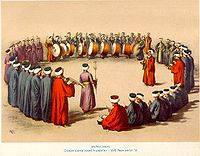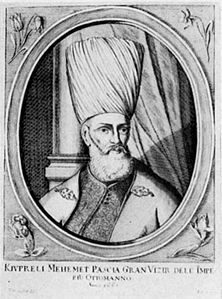- History of Ottoman Albania
-
History of Albania 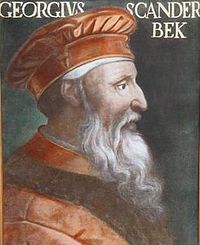 PrehistoryAntiquityMiddle AgesOttoman AlbaniaPost-IndependenceContemporary Albania
PrehistoryAntiquityMiddle AgesOttoman AlbaniaPost-IndependenceContemporary AlbaniaAlbania Area of the of Ottoman Empire ← 
1479–1912  →
→History - Conquest 1479 - Independence 1912 The land that is today Albania was controlled by the Ottoman Empire from 1481 until 1912.
Contents
Ottoman Rule
The Ottoman Turks expanded their empire from Anatolia to the Balkans in the 14th century. They crossed the Bosporus in 1352, and in 1389 they crushed a Serbian army in the Battle of Kosovo. Europe gained a brief respite from Ottoman pressure in 1402 when the Mongol leader, Tamerlane, attacked Anatolia from the east, killed the Turks' absolute ruler, the Sultan, and sparked a civil war. When order was restored, the Ottomans renewed their westward progress. In 1453, Sultan Mehmed II's forces overran Constantinople and killed the last Byzantine emperor.[1]
The division of the Albanian-populated lands into small, quarreling fiefdoms ruled by independent feudal lords and tribal chiefs made them easy prey for the Ottoman armies. In 1385, the Albanian ruler of Durrës, Karl Thopia, appealed to the sultan for support against his rivals, the Balšić noble family. An Ottoman force quickly marched into Albania along the Via Egnatia and routed Balsha II in the Battle of Savra. The principal Albanian clans soon swore fealty to the Ottoman Empire. Gjirokastra became the county town of the Sanjak of Albania in 1419.[2] Sultan Murad II launched the major Ottoman onslaught in the Balkans in 1423, and the Turks took Ioannina in 1431 and Arta, on the Ionian coast, in 1449. The Turks allowed conquered Albanian clan chiefs to maintain their positions and property, but they had to pay tribute, send their sons to the Turkish court as hostages, and provide the Ottoman army with auxiliary troops.[1]
The Albanians' resistance to the Turks in the mid-15th century won them acclaim all over Europe. Gjon Kastrioti of Krujë was one of the Albanian clan leaders who submitted to Turkish suzerainty. He was compelled to send his four sons to the Ottoman capital to be trained for military service. The youngest, George Kastrioti (1403–68), who would become the Albanians' national hero, captured the sultan's attention. Renamed Iskander when he converted to Islam, the young man participated in military expeditions to Asia Minor and Europe. When appointed to administer a Balkan district, Iskander became known as Skanderbeg. After Ottoman forces under Skanderbeg's command suffered defeat in a battle near Niš, in present-day Serbia, in 1443, the Albanian rushed to Krujë and tricked a Turkish pasha into surrendering him the Albanian fortress. Skanderbeg then reembraced Roman Catholicism and declared a holy war against the Turks.[1]
On March 1, 1444, Albanian chieftains gathered in the cathedral of Lezhë with the prince of Montenegro and delegates from Venice and proclaimed Skanderbeg commander of the Albanian resistance. All of Albania, including most of Epirus, accepted his leadership against the Ottoman Turks, but local leaders kept control of their own districts. Under a red flag bearing Skanderbeg's heraldic emblem, an Albanian force of about 10,000-15.000 men held off Ottoman campaigns against their lands for twenty-four years. Three times the Albanians overcame sieges of Krujë. In 1450, the Albanians routed Sultan Murad II himself. Later, they repulsed attacks led by Sultan Mehmed II in 1466 and 1467. In 1461, Skanderbeg went to the aid of his suzerain, King Alfonso I of Naples, against the kings of Sicily. The government under Skanderbeg was unstable, however, and at times local Albanian rulers cooperated with the Ottoman Turks against him.[1]
With political and minor material support from the Kingdom of Naples and the Vatican, resistance to the Ottoman Empire continued for 35 years. Krujë fell to the Ottoman Turks only in 1478 after the death of Skanderbeg; Shkodër succumbed in 1479 after a fifteen-month siege; and the Venetians evacuated Durrës in 1501. The conquest triggered a great Albanian exodus to southern Italy, especially to the kingdom of Naples, as well as to Sicily, Romania and Egypt. Most of the Albanian refugees belonged to the Orthodox Church. The Albanians of Italy significantly influenced the Albanian national movement in future centuries, and Albanian Franciscan priests, most of whom were descended from émigrés to Italy, played a significant role in the preservation of Catholicism in Albania's northern regions.[1]
The memory of the mid-fifteenth century resistance under Skanderbeg continues to be important to Albanians,[citation needed] and his family's banner, bearing a black two-headed eagle on a red field, became the flag under which the Albanian national movement rallied centuries later.
After the death of Skenderbeg and the fall of Kruje, the Ottoman Empire gained control of the vast ethnic Albanian territories and many new changes began to take place.
Among the biggest transformation was that the Albanain population gradually began to convert to Islam through the teachings of Bektashism, in order to gain considerable advantages in the Ottoman trade networks, bureaucracy and army. Many Albanians were recruited into the Ottoman Janissary and Devşirme and 42 Grand Viziers of the Ottoman Empire were of Albanian origin. The most prominent Albanians during Ottoman rule were: Davud Pasha, Hamza Kastrioti, Iljaz Hoxha, Nezim Frakulla, Köprülü Mehmed Pasha, Ali Pasha, Edhem Pasha, Omer Vrioni, Haxhi Shehreti, Ali Pasha of Gucia, Ibrahim Pasha of Berat, Köprülü Fazıl Ahmed, Muhammad Ali of Egypt, Kara Mahmud Bushati, Kara Murad Pasha, Ahmet Kurt Pasha, Mustafa Bushati, Ibrahim Bushati, Sedefkar Mehmed Agha.
Albanians also played a crucial role during the Ottoman–Venetian War (1499–1503), Ottoman–Hungarian Wars and Ottoman–Habsburg wars before gaining Independence.
18th century
Further information: Albanian National Awakening#1911 Highlanders Uprising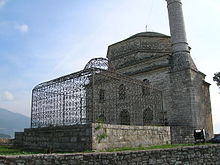 The Fethiye Mosque just adjacent to Ali Pasha's grave.
The Fethiye Mosque just adjacent to Ali Pasha's grave.
The weakening of Ottoman central authority and the timar system brought anarchy to the Albanian-populated lands. In the late 18th century, two Albanian centers of power emerged: Shkodër, under the Bushati family; and Ioannina, under Ali Pasha of Tepelenë. When it suited their goals, both places cooperated with the Sublime Porte, and when it was expedient to defy the central government, each acted independently.[3]
The Bushati family dominated the Shkodër region through a network of alliances with various highland tribes. Kara Mahmud Bushati attempted to establish an autonomous principality and expand the lands under his control by playing off Austria and Russia against the Sublime Porte. In 1785, Kara Mahmud's forces attacked Montenegrin territory, and Austria offered to recognize him as the ruler of all Albania if he would ally himself with Vienna against the Sublime Porte. Seizing an opportunity, Kara Mahmud sent the sultan the heads of an Austrian delegation in 1788, and the Ottomans appointed him governor of Shkodër. When he attempted to wrest land from Montenegro in 1796, however, he was defeated and beheaded. Kara Mahmud's brother, Ibrahim Bushati, cooperated with the Sublime Porte until his death in 1810, but his successor, Mustafa Pasha Bushati, proved to be recalcitrant despite participation in Ottoman military campaigns against Greek revolutionaries and rebel pashas. He cooperated with the mountain tribes and brought a large area under his control.[3]
South of the Shkumbini River, the mostly peasant Tosks lived in compact villages under elected rulers. Some Tosks living in settlements high in the mountains maintained their independence and often escaped payment of taxes. The Tosks of the lowlands, however, were easy for the Ottoman authorities to control. The Albanian tribal system disappeared there, and the Ottomans imposed a system of military fiefs under which the sultan granted soldiers and cavalrymen temporary landholdings, or timars, in exchange for military service. By the 18th century, many military fiefs had effectively become the hereditary landholdings of economically and politically powerful families who squeezed wealth from their hard-strapped Christian and Muslim tenant farmers. The beys, like the clan chiefs of the northern mountains, became virtually independent rulers in their own provinces, had their own military contingents, and often waged war against each other to increase their landholdings and power. The Sublime Porte attempted to press a divide-and-rule policy to keep the local beys from uniting and posing a threat to Ottoman rule itself, but with little success.[4]
19th century
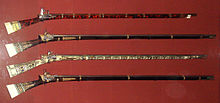 Janissary guns from the year 1826, during the Auspicious Incident.
Janissary guns from the year 1826, during the Auspicious Incident.
Ottoman-Albanian relations worsened in the year 1826 during the reign of Mahmud II, he had instigated the notorious Auspicious Incident and the turmoil that followed caused the violent dissolution of the Janissary, Devşirme and the entire Balkan Muslim leadership in Rumelia causing a new wave of revolts and instability in the gradually weakening Ottoman Empire.
After crushing the Bushatis and Ali Pasha, the Sublime Porte introduced a series of reforms, known as the tanzimat, which were aimed at strengthening the empire by reining in fractious pashas. The timars officially became large individual landholdings, especially in the lowlands. In 1835, the Sublime Porte divided the Albanian-populated lands into the vilayets of Janina and Rumelia and dispatched officials from Constantinople to administer them. This provoked a series of revolts in 1843–1844, but they were suppressed by the Ottoman army.
After 1865, the central authorities redivided the Albanian lands between the vilayets of Scutari, Janina, and Monastir. The reforms angered the highland Albanian chieftains, who found their privileges reduced with no apparent compensation, and the authorities eventually abandoned efforts to control them. Ottoman troops crushed local rebellions in the lowlands, however, and conditions there remained bleak. Large numbers of Tosks emigrated to join sizable Albanian émigré communities in Romania, Egypt, Bulgaria, Constantinople, southern Italy, and later the United States.[3]
Against the Young Turks
Further information: Albanian National Awakening#1911 Highlanders Uprising The 4 Ottoman vilayets (Kosovo, Scutari, Monastir and Janina), proposed to form the Albanian Vilayet.
The 4 Ottoman vilayets (Kosovo, Scutari, Monastir and Janina), proposed to form the Albanian Vilayet.
In 1906 opposition groups in the Ottoman Empire emerged, one of which evolved into the Committee of Union and Progress, more commonly known as the Young Turks, which proposed restoring constitutional government in Constantinople, by revolution if necessary. In July 1908, a month after a Young Turk rebellion in Macedonia supported by an Albanian uprising in Kosovo and Vardar Macedonia escalated into widespread insurrection and mutiny within the imperial army, Sultan Abdül Hamid II agreed to demands by the Young Turks to restore constitutional rule. Many Albanians participated in the Young Turks uprising, hoping that it would gain their people autonomy within the empire. The Young Turks lifted the Ottoman ban on Albanian-language schools and on writing the Albanian language. As a consequence, Albanian intellectuals meeting in Bitola in 1908 chose the Latin alphabet as a standard script. The Young Turks, however, were set on maintaining the empire and not interested in making concessions to the myriad nationalist groups within its borders. After securing the abdication of Abdül Hamid II in April 1909, the new authorities levied taxes, outlawed guerrilla groups and nationalist societies, and attempted to extend Constantinople's control over the northern Albanian mountainmen. In addition, the Young Turks legalized the bastinado, or beating with a stick, even for misdemeanors, banned carrying rifles, and denied the existence of an Albanian nationality. The new government also appealed for Islamic solidarity to break the Albanians' unity and used the Muslim clergy to try to impose the Arabic alphabet.
The Albanians refused to submit to the Young Turks' campaign to "Ottomanize" them by force. New Albanian uprisings began in Kosovo and the northern mountains in early April 1910. Ottoman forces quashed these rebellions after three months, outlawed Albanian organizations, disarmed entire regions, and closed down schools and publications. Montenegro, preparing to grab Albanian-populated lands for itself, supported a 1911 uprising by the mountain tribes against the Young Turks regime that grew into a widespread revolt. Unable to control the Albanians by force, the Ottoman government granted concessions on schools, military recruitment, and taxation and sanctioned the use of the Latin script for the Albanian language. The government refused, however, to unite the four Albanian-inhabited vilayets into one, Albanian vilayet.
Governing structure
Administratively, the Ottomans divided the Albanian-inhabited lands among a number of districts, or vilayets. The Ottoman authorities did not initially stress conversion to Islam.[4]
By 1479, the entire country, except for Durrës, Ulcinj and Bar, was under Ottoman suzerainty. Prominent viziers and pashas hailed from Albania, and were appointed to their posts long before the majority of Albanians professed Islam.
Administrative
- For details of : State Organization
The Ottoman sultan considered himself God's agent on Earth, the leader of a religious—not a national—state whose purpose was to defend and propagate Islam. Non-Muslims paid extra taxes and held an inferior status, but they could retain their old religion and a large measure of local autonomy. By converting to Islam, individuals among the conquered could elevate themselves to the privileged stratum of society. In the early years of the empire, all Ottoman high officials were the sultan's bondsmen the children of Christian subjects chosen in childhood for their promise, converted to Islam, and educated to serve. Some were selected from prisoners of war, others sent as gifts, and still others obtained through devshirme, the tribute of children levied in the Ottoman Empire's Balkan lands. Many of the best fighters in the sultan's elite guard, the janissaries, were conscripted as young boys from Christian Albanian families, and high-ranking Ottoman officials often had Albanian bodyguards.[4]
Taxation
During the centuries of Ottoman rule, the Albanian lands remained one of Europe's most backward areas.[citation needed]The backwardness of Albania under Ottoman rule, is partly not true. According to historian Zija Shkodra, Albania was developed as much as the rest of the Balkans. In the mountains north of the Shkumbini River, Geg herders maintained their self-governing society base on clans. An association of clans was called a bajrak. Taxes on the northern tribes were difficult if not impossible for the Ottomans to collect because of the rough terrain and fierceness of the Albanian highlanders. Some mountain tribes succeeded in defending their independence through the centuries of Ottoman rule, engaging in intermittent guerrilla warfare with the Ottoman Turks, who never deemed it worthwhile to subjugate them. Until recent times, Geg clan chiefs, or bajraktars, exercised patriarchal powers, arranged marriages, mediated quarrels, and meted out punishments. The tribesmen of the northern Albanian mountains recognized no law but the Code of Lekë Dukagjini (Kanuni i Lekë Dukagjinit), a collection of tribal laws transcribed in the 14th century by a Roman Catholic priest. The code regulates a variety of subjects, including blood vengeance. Even today, many Albanian highlanders regard the canon as the supreme law of the land.[4]
Religion
For more details on this topic, see Millet (Ottoman Empire).Five centuries of Ottoman rule grouped the Albanian people along religious, regional, and tribal lines. In the early 17th century, however, Albanians converted to Islam in large numbers. Within a century, the Muslim Albanian community was the largest religious community in the country. Albanians in this time were divided into two distinct tribal and dialectal groupings: the Gegs and Tosks (see Albanian language). In the rugged northern mountains, Geg shepherds lived in a tribal society often completely independent of Ottoman rule. In the south, peasant Muslim and Orthodox Tosks worked the land for Muslim beys, provincial rulers who frequently revolted against the sultan's authority.
In the early 17th century, many Albanian converts to Islam migrated elsewhere within the Ottoman Empire and found careers in the Ottoman military and government. Some attained powerful positions in the Ottoman administration. About thirty Albanians rose to the position of grand vizier, chief deputy to the sultan himself. In the second half of the seventeenth century, the Albanian Köprülü family provided four grand viziers, who fought against corruption, temporarily shored up eroding central government control over rapacious local beys, and won several military victories.
As early as the eighteenth century, a mystic Islamic sect, the Bektashi dervishes, spread into the empire's Albanian-populated lands. Probably founded in the late 13th century in Anatolia, Bektashism became the janissaries' official faith in the late 16th century. The Bektashi sect contains features quite distinct from normative Islam and emphasizes man as a reflection of the Divine. Women, unveiled, participate in Bektashi ceremonies on an equal basis, and the celebrants use wine despite the ban on alcohol in the Sharia. The Bektashis became the largest religious group in southern Albania after the sultan disbanded the janissaries in 1826. Bektashi leaders played key roles in the Albanian nationalist movement of the late nineteenth century and were to a great degree responsible for the Albanians' traditional tolerance of religious differences.
In the 19th century, the Ottoman sultans tried in vain to shore up their collapsing empire by introducing a series of reforms aimed at reining in recalcitrant local officials and dousing the fires of nationalism among its myriad peoples. The power of nationalism, however, proved too strong to counteract.
Albanian nationalism
Main article: National awakening and the birth of AlbaniaAs a result of contacts maintained between the Tosks and their relatives living or returning from abroad, foreign ideas began to seep into Albania.
See also
- List of Albanian Grand Viziers
References
- ^ a b c d e Raymond Zickel and Walter R. Iwaskiw (1994). "Albania: A Country Study ("The Ottoman Conquest of Albania")". http://countrystudies.us/albania/17.htm. Retrieved 9 April 2008.
- ^ Riza, Emin (1992). "Ethnographic and open-air museums". UNESCO, Paris. http://unesdoc.unesco.org/images/0009/000929/092980eo.pdf. Retrieved March 18, 2011.
- ^ a b c Raymond Zickel and Walter R. Iwaskiw (1994). "Albania: A Country Study ("Local Albanian Leaders in the Early 19th Century")". http://countrystudies.us/albania/19.htm. Retrieved 9 April 2008.
- ^ a b c d Raymond Zickel and Walter R. Iwaskiw (1994). "Albania: A Country Study ("Albanians under Ottoman Rule")". http://countrystudies.us/albania/18.htm. Retrieved 9 April 2008.
History of modern states under the Ottoman Empire Africa Asia Europe Albania · Bosnia and Herzegovina · Bulgaria · Greece · Hungary · Kosovo · Macedonia · Montenegro · Serbia Albania topics
Albania topicsIndex · Outline Symbols People Language · List of Albanians · Albanian-Americans · Arbëreshë people · Arvanites · Writers · Enver Hoxha · Mother Teresa · Ismail Qemali · Sali Berisha · Skanderbeg · Ismail KadareHistory Origins · Praevalitana · Epirus Nova · Middle Ages · Albania under the Bulgarian Empire · Albania under the Serbian Empire · Principality of Arbër · Kingdom of Albania · Albanian Principalities in Middle Ages · League of Lezhë · Venetian Albania · Ottoman Albania · Albanian Pashaliks · Massacre of the Albanian Beys · Albanian National Awakening · Revolts of 1833–1839 · Revolt of 1843–1844 · Revolt of 1847 · League of Prizren · League of Peja · Revolt of 1910 · Battle of Deçiq · Independence Declaration · Provisional Government of Albania · Albania during the Balkan Wars · Principality of Albania (1914–1925) · Italian Protectorate on southern Albania · Vlora War · Republic of Mirdita · Albanian Republic (1925–1928) · Albanian Kingdom (1928–1939) · Albania under Italy (Invasion · Colonization) · Albania under Germany · Resistance · Communist Albania (1946–1992) · Post-Communist Albania (since 1992) · Timeline to 1993, 1994–PresentPolitics Constitution · Heads of State · Prime Minister · Parliament · Political parties · Elections (2007) · Counties · Districts · Municipalities · Foreign relations · History of Kosovo · Kosovo War · LGBT rightsGeography Cities: Tirana · Cities; Geographical Regions: Northern Mountain Range · Southern Mountain Range · Western Lowlands · Central Mountain Range Mountains: Mount Dajti · Golem Korab · Dinaric Alps · Mount Korab · Tomorri Mountain; Seas: Adriatic Sea · Ionian Sea; Rivers: Drin River · Buna River · Vjosë · Black Drin; Lakes: Lake Skadar · Lake Ohrid · Lake Prespa; Lagoons: Karavasta · Narta;
Plains: Myzeqe · Korçë Plain · Zadrima; Capes: Cape of Gjuhëz · Cape of Rodon; National Parks: Butrint · Lura · Llogara · Thethi · Valbona Valley · Shebenik-Jabllanica · Fir of Hotova · Karaburun-Sazan · ListEconomy Military Military · Air Force · Rapid Reaction Brigade · Naval Defense Forces · Joint Forces Command · Support CommandCulture Languages · Costume · Nationalism · Literature · Cinema · Cuisine · Emigration · Music · Sports · Holidays · Religion · Television · Radio · Mythology · Epic PoetryReligion Categories  Category ·
Category ·  Portal ·
Portal ·  WikiProjectCategories:
WikiProjectCategories:- States and territories disestablished in 1912
- Ottoman Albania
- Islam in Albania
Wikimedia Foundation. 2010.


